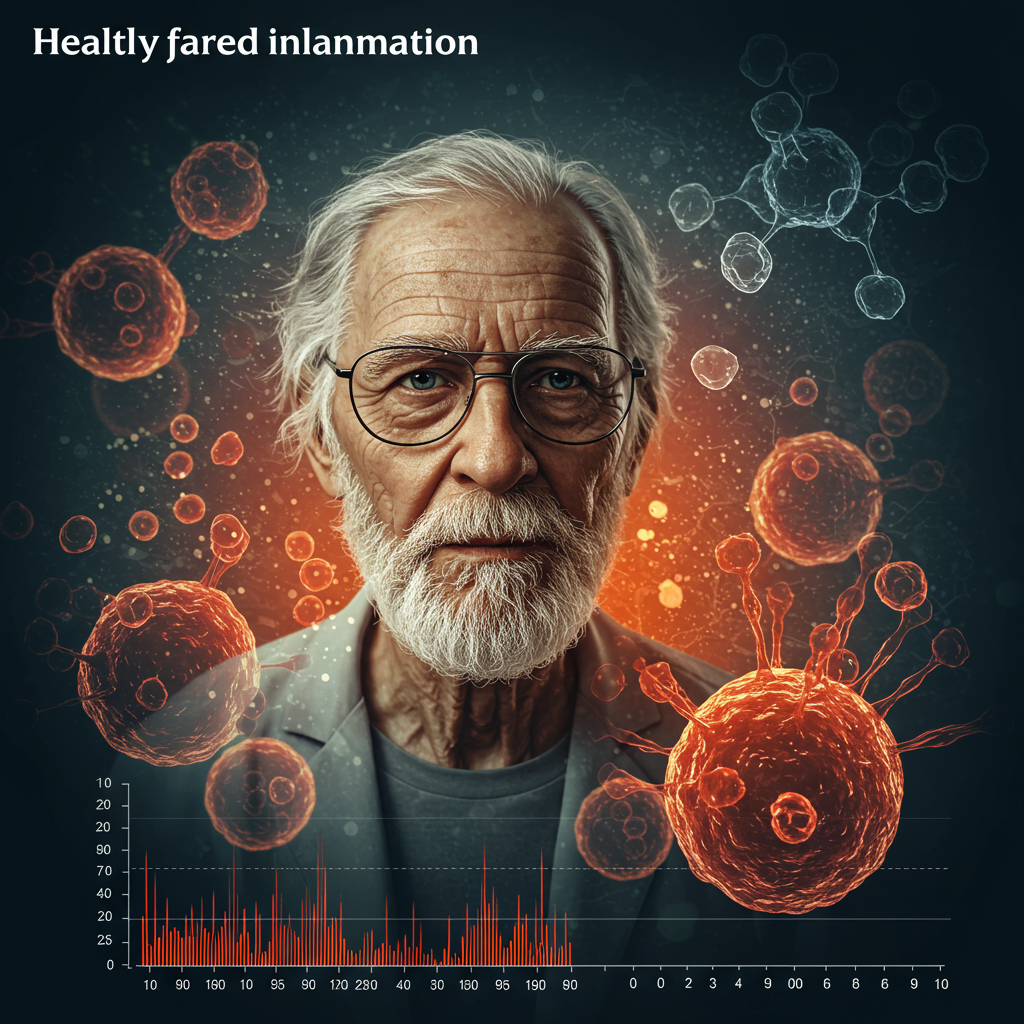Could chronic inflammation as you age be less about getting older and more about how you live? Often considered an unavoidable part of the aging process, a phenomenon called “inflammaging” – a persistent, low-grade inflammation that increases with age – has been linked to numerous age-related diseases. But groundbreaking new research challenges this long-held assumption, suggesting that this specific type of age-related inflammation might not be a universal human experience after all. Instead, it appears significantly tied to factors found in industrialized lifestyles.
What is Inflammaging and Why Does it Matter?
Think of inflammaging as a slow burn within your body. It’s not the acute inflammation you get from an injury or infection, which is a crucial part of healing. Inflammaging is a chronic, low-grade inflammatory state that science has observed tends to increase as people get older.
Why is this significant? This smoldering inflammation is believed to contribute to many of the health issues we associate with aging, such as heart disease, diabetes, Alzheimer’s, and frailty. It’s been so consistently observed in studies of certain populations that it’s often listed as a key “hallmark” of aging, a fundamental process driving age-related decline.
However, scientists have struggled to agree on the best way to measure this phenomenon consistently, particularly by looking at levels of various signaling proteins called cytokines in the blood. This lack of a standardized measurement tool raised questions: Are we measuring the same thing everywhere? And is this age-related increase in inflammation truly universal across all human populations, regardless of their environment or way of life?
The Study: Comparing Inflammaging Across Diverse Populations
To tackle this question, a team of researchers conducted a revealing study. They started with a specific “inflammaging blueprint” or pattern of 19 different cytokines previously identified in an Italian population (from the InCHIANTI study), known for their industrialized lifestyle and associated health profiles.
The core idea was to see if this specific blueprint of age-related inflammation could be found and measured in vastly different human groups. If inflammaging is a universal hallmark of aging, this pattern should look similar and increase with age everywhere.
The researchers applied this “Italian blueprint” to three other populations:
- Singapore Longitudinal Aging Study (SLAS): Another group living in an industrialized, urban environment.
- Tsimane from the Bolivian Amazon: An indigenous population with a traditional, non-industrialized lifestyle, characterized by high physical activity and distinct pathogen exposure patterns.
- Orang Asli from Peninsular Malaysia: Another indigenous population also living a more traditional lifestyle away from extensive industrialization.
- Consider Gut Health: A healthy gut microbiome is linked to reduced inflammation. Eating fiber-rich foods and fermented foods can help.
- www.nature.com
By comparing the cytokine patterns, their association with age, and their links to health outcomes across these four diverse groups, the study aimed to uncover whether inflammaging, as typically understood, is truly a universal aspect of human aging or something more specific.
How They Measured Inflammaging
The study didn’t just look at individual cytokine levels. They analyzed how a group of cytokines behaved together, essentially looking for a specific pattern or “axis structure” that represented the inflammaging state identified in the Italian data. They then checked if this pattern became more pronounced with age in each population and if higher levels of this pattern were linked to age-related diseases.
Key Findings: A Tale of Two Worlds
The results revealed a striking difference between the industrialized populations and the indigenous groups.
Inflammaging in Industrialized Settings
In the Singaporean population (SLAS), the cytokine pattern linked to inflammaging was found to be quite similar to that seen in the Italian population (InCHIANTI). There were minor variations in how specific cytokines like IL-6 and IL-1RA factored in, but the overall structure of age-associated inflammation largely matched. Crucially, in both the Italian and Singaporean cohorts, this inflammaging axis did increase with age, and higher levels were associated with age-related health problems. This aligns with the common understanding of inflammaging based on research predominantly conducted in industrialized Western populations.
The Indigenous Contrast: Less Inflammaging, Different Patterns
The picture was dramatically different for the Tsimane and Orang Asli.
When the researchers looked for the specific Italian-derived inflammaging axis in these indigenous groups, they found that the cytokine patterns were “markedly different.” The way cytokines related to each other in the Tsimane and Orang Asli didn’t match the blueprint from the industrialized populations.
Even more significantly, this measure of inflammaging showed little to no association with increasing age in the Tsimane and Orang Asli. Aging happened, but this specific inflammatory signature didn’t necessarily get worse as people got older, unlike in Italy and Singapore.
Furthermore, applying this standard inflammaging measure showed no association with typical age-related diseases in the Tsimane and Orang Asli cohorts. Despite aging, the link between this specific inflammatory pattern and common age-related health issues, so clear in industrialized groups, was absent.
Why the Difference? The Power of Environment and Lifestyle
The study’s conclusion is powerful and paradigm-shifting: inflammaging, as defined and measured using the standards developed in industrialized populations, appears to be largely a byproduct of industrialized lifestyles. It is not an inevitable, universal aspect of human aging.
This suggests that factors inherent in modern, industrialized environments and ways of life are driving the specific inflammatory patterns observed as people age in these settings. What might these factors be?
While the study doesn’t definitively pinpoint the exact causes, the stark contrast between populations points strongly to environmental and lifestyle influences. Think about the differences:
Diet: Industrialized diets often feature more processed foods, refined sugars, and unhealthy fats, which are known drivers of chronic inflammation, compared to more traditional, whole-food-based diets.
Physical Activity: Sedentary lifestyles are common in industrialized nations, while traditional lifestyles often involve high levels of physical activity for subsistence.
Exposure to Microbes: Indigenous populations often have different patterns of exposure to pathogens, including higher burdens of certain infections like helminths (parasitic worms). Research suggests that managing these infections might lead to different immune system “set points” or responses compared to populations in highly hygienic environments.
Environmental Toxins & Stress: Exposure to pollution, chronic psychosocial stress, and other modern environmental factors could play a role.
This research aligns with the concept of “evolutionary mismatch,” where our bodies, evolved for ancestral environments, face health challenges when exposed to modern, industrialized conditions.
Implications for Understanding Aging and Health
This finding is crucial for the future of aging research. Much of what we know about aging and age-related diseases comes from studies on people in industrialized societies (often referred to as “WEIRD” populations: Western, Educated, Industrialized, Rich, Democratic). This study highlights that findings from these groups might not be universally applicable.
It suggests that instead of inflammaging being an unstoppable consequence of cellular wear and tear inherent to aging itself, it might be a modifiable outcome influenced heavily by external factors. This shifts the focus from just slowing down aging processes to actively mitigating the environmental and lifestyle drivers of age-related inflammation.
Understanding the diverse ways human immune systems age in different environments could unlock new strategies for promoting healthier aging globally. It underscores the need for research that includes diverse populations to build a truly comprehensive picture of human health and aging.
What Can You Do? Actionable Insights
The most hopeful takeaway from this study is that if inflammaging is largely a product of lifestyle, you likely have significant power to influence your own inflammatory profile as you age. While you can’t change your chronological age, you can modify the environmental and lifestyle factors that contribute to chronic inflammation.
Here are some steps based on what we know about inflammation and healthy aging:
Adopt an Anti-Inflammatory Diet: Focus on whole foods, fruits, vegetables, lean protein, and healthy fats (like those found in olive oil and fatty fish). Limit processed foods, sugary drinks, and excessive red meat.
Stay Active: Regular physical activity is a powerful anti-inflammatory agent. Aim for a mix of aerobic exercise and strength training.
Manage Stress: Chronic stress is a major contributor to inflammation. Find effective stress-reduction techniques like mindfulness, meditation, or hobbies.
Prioritize Sleep: Poor sleep disrupts immune function and increases inflammation. Aim for 7-9 hours of quality sleep per night.
Maintain a Healthy Weight: Excess body fat, particularly around the abdomen, is pro-inflammatory.
Avoid Smoking and Limit Alcohol: Both are significant drivers of inflammation.
By focusing on these elements of a healthy lifestyle, you may be able to reduce the impact of industrialized-lifestyle-driven inflammaging and potentially promote a healthier, more vibrant aging process.
Frequently Asked Questions
What is inflammaging and why is this study important?
Inflammaging is a term for the chronic, low-grade inflammation often observed as people age in industrialized societies, linked to many age-related diseases. This study is important because it tested whether this phenomenon is universal. It found that using a typical measure of inflammaging from an Italian population, the pattern wasn’t seen or linked to age/disease in indigenous groups (Tsimane, Orang Asli), suggesting inflammaging is not an inevitable part of aging for all humans but is strongly linked to industrialized lifestyles.
How did the lifestyles of different populations affect inflammaging in the study?
The study compared industrialized groups (Italy, Singapore) with indigenous, non-industrialized groups (Tsimane, Orang Asli). While the industrialized groups showed the expected increase in inflammaging with age and link to disease, the indigenous groups did not show this pattern using the same measure. This highlights that factors differing between these lifestyles – such as diet, physical activity levels, exposure to pathogens, and environmental factors – likely play a significant role in driving or preventing the development of specific age-related inflammatory profiles.
Can I prevent or reduce inflammaging through lifestyle changes?
Yes, the study’s findings strongly suggest that lifestyle factors are key drivers of the inflammaging pattern observed in industrialized populations. While aging is natural, chronic inflammation linked to lifestyle is often modifiable. Adopting habits like eating an anti-inflammatory diet (rich in whole foods), exercising regularly, managing stress, getting enough sleep, maintaining a healthy weight, and avoiding smoking can help reduce chronic inflammation and potentially mitigate inflammaging.
Conclusion
The notion that age brings an inevitable surge in chronic inflammation, or “inflammaging,” has been a staple in aging research. However, this groundbreaking study provides compelling evidence that this may not be the case for everyone. By comparing diverse human populations, researchers have shown that the specific pattern of age-related inflammation observed in industrialized societies appears to be largely a consequence of those very lifestyles, not a universal feature of aging itself. This revolutionary insight not only broadens our understanding of how different environments shape the aging process but also offers a powerful message of hope: by making conscious choices about our diet, activity, and environment, we may hold significant influence over the chronic inflammation that impacts our health as we get older. The path to healthier aging might lie not just in understanding the biology of time, but in shaping the way we live each day.
Word Count Check: 1168 words



